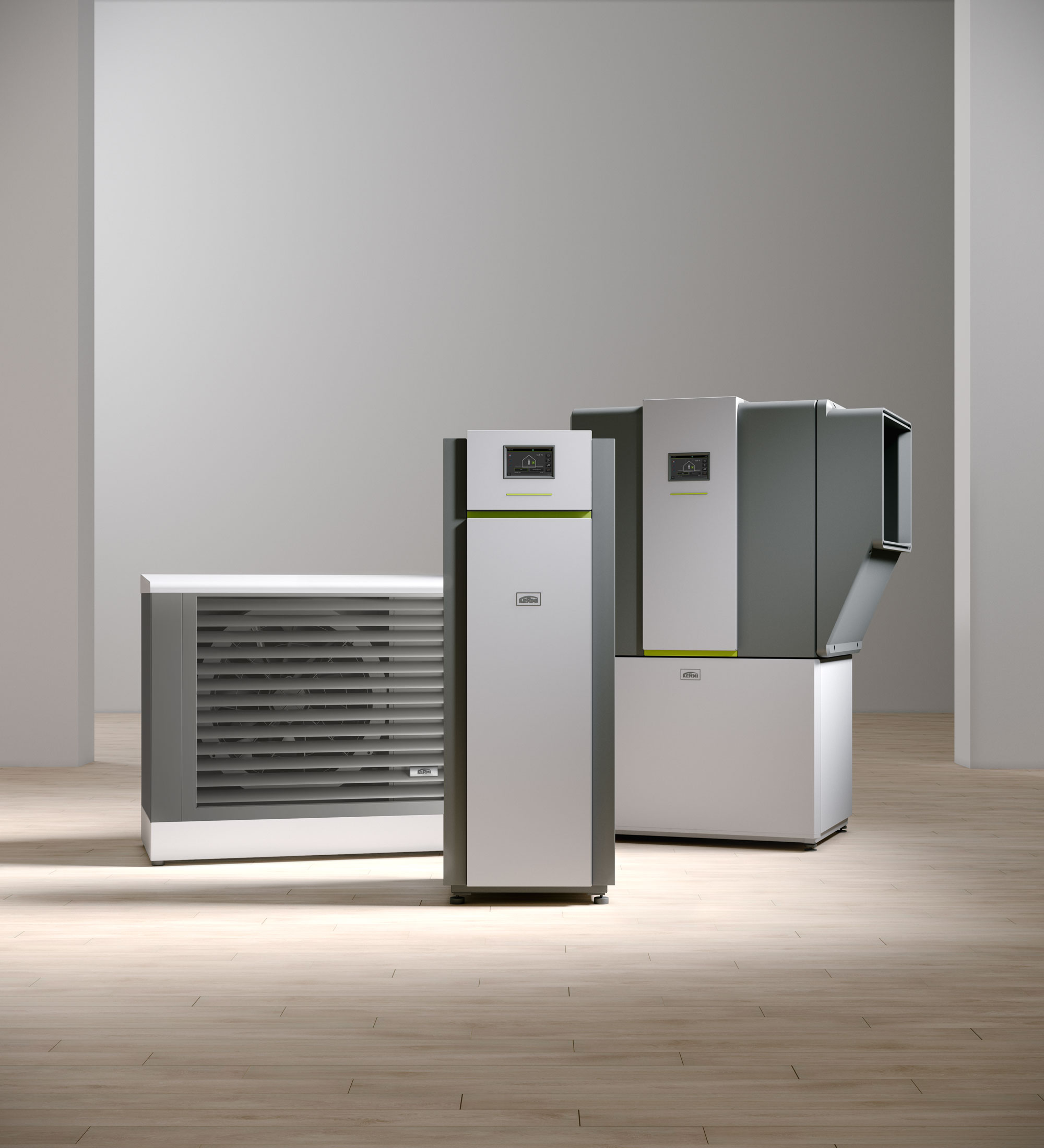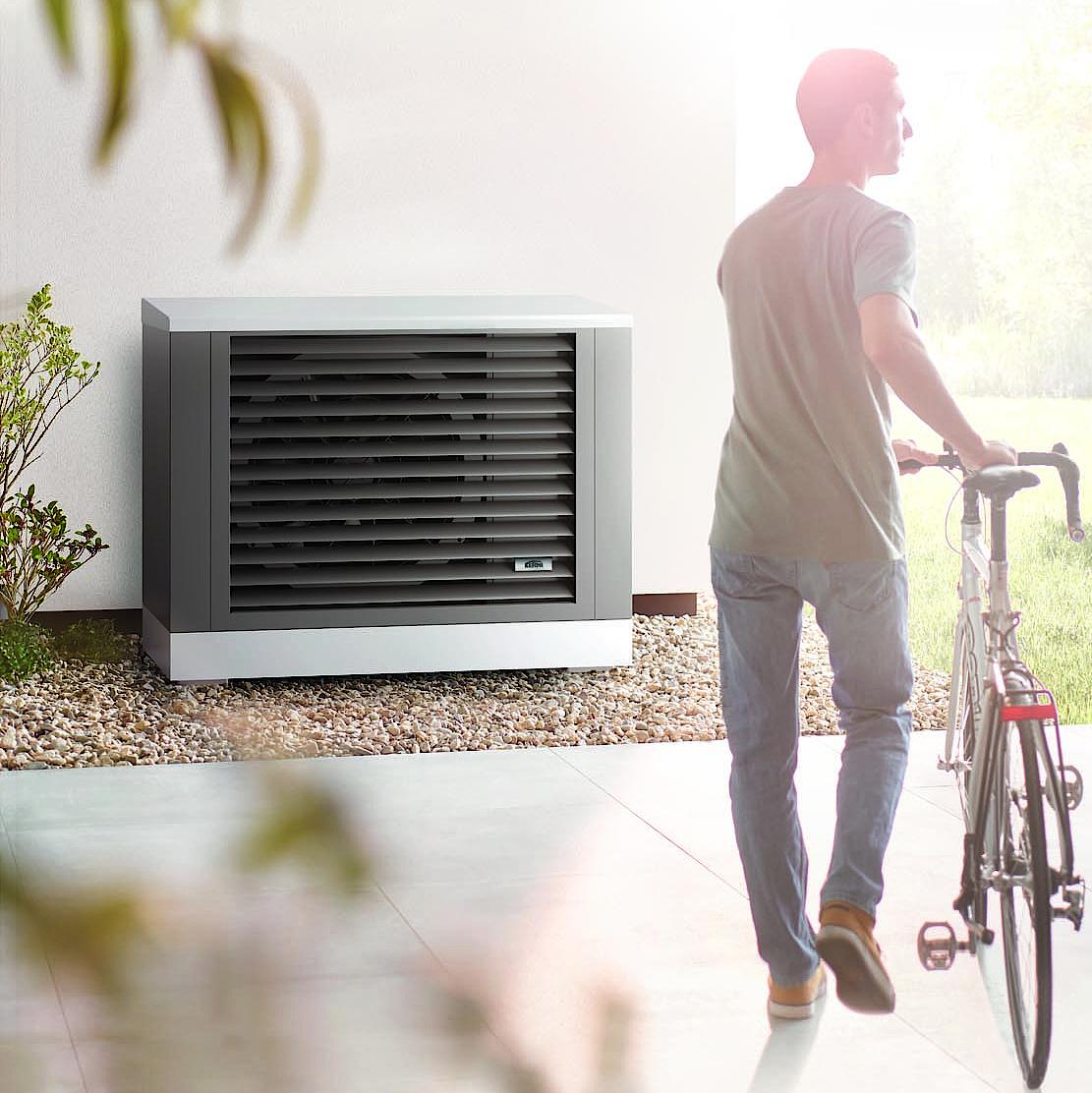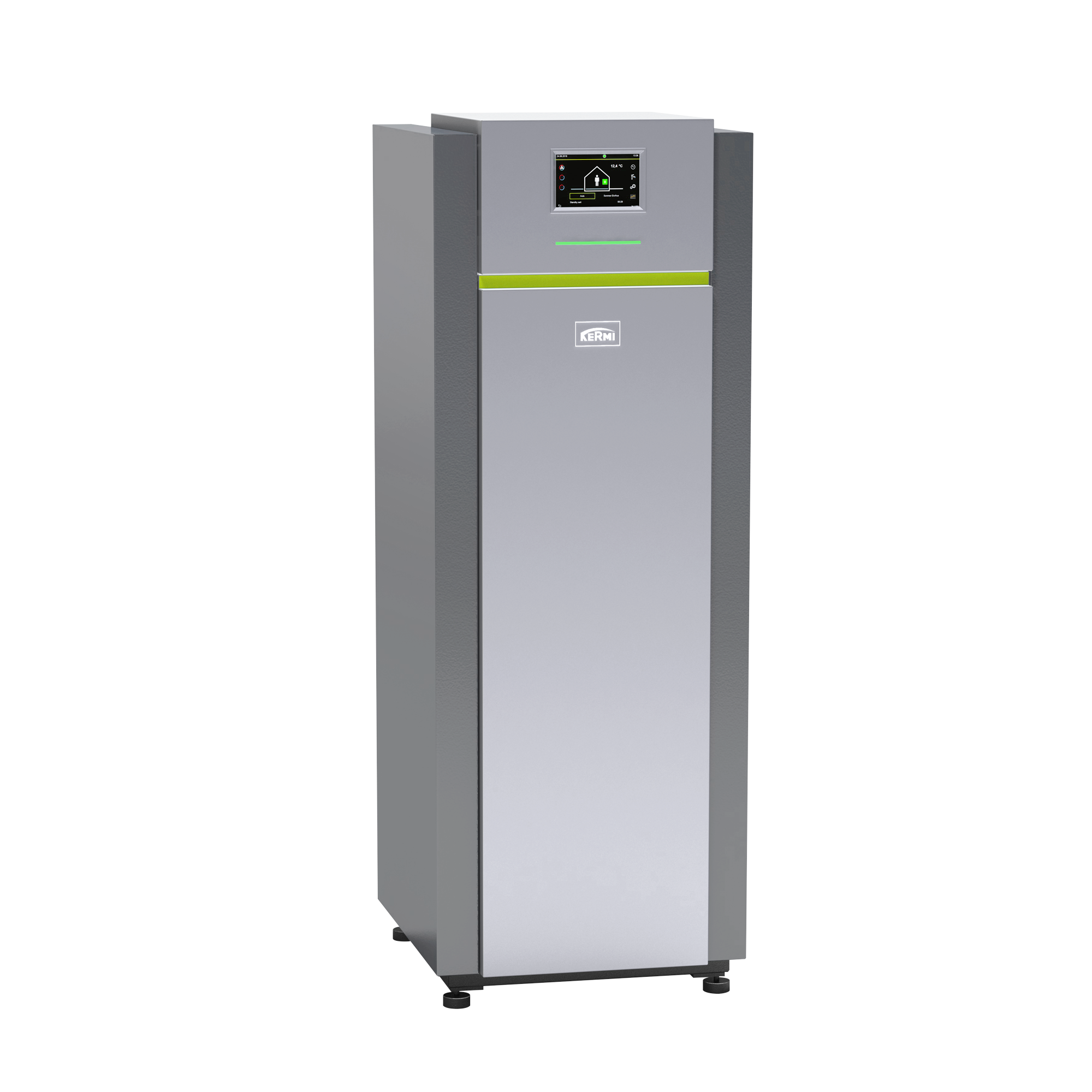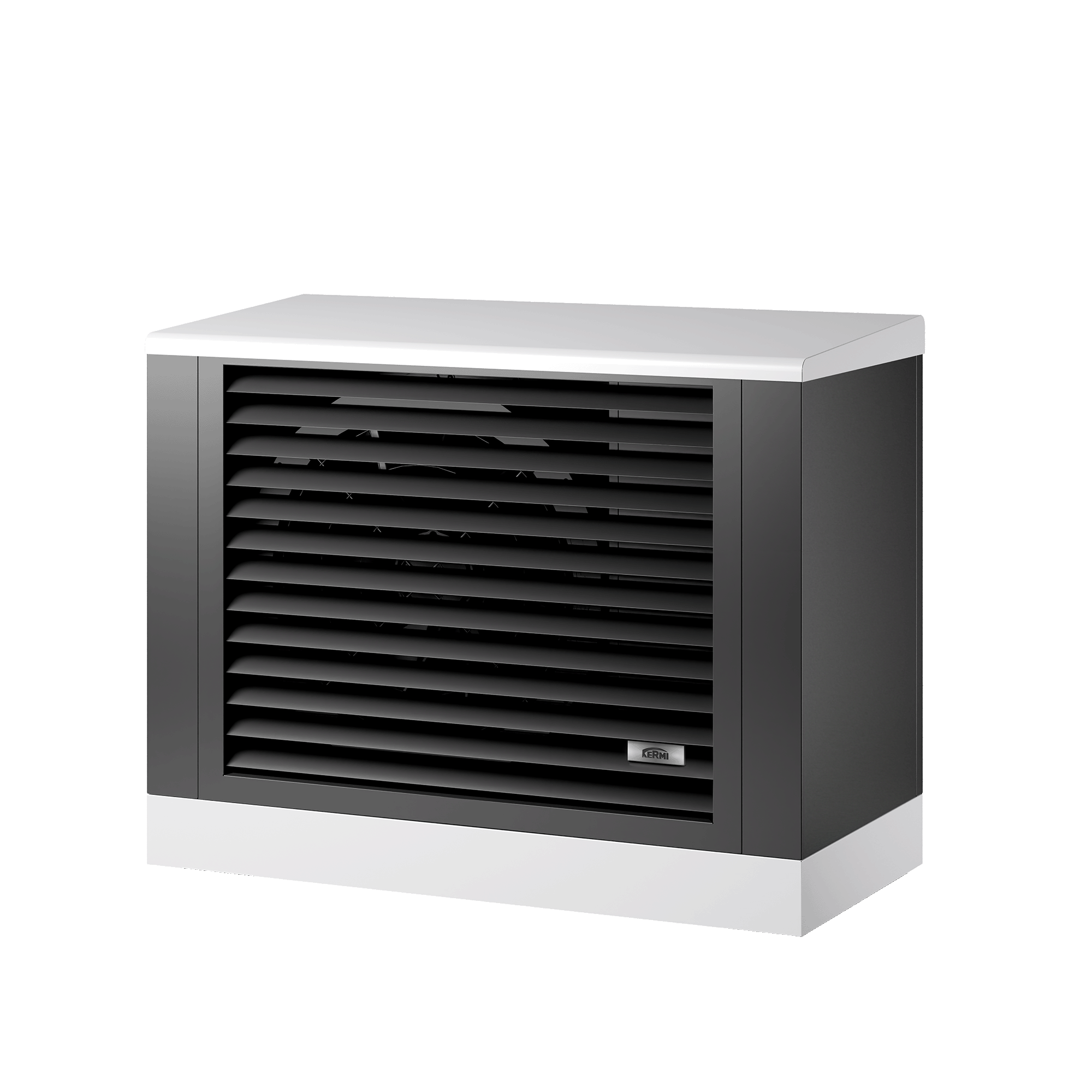Cooling with the heat pump
Kermi innovations

How does a heat pump cool?
Heat pumps can also be used to cool living spaces if the necessary technical requirements are met. Whether they come in air/water, brine/water, or water/water forms, heat pumps cool via the water pipes of the underfloor or wall heating without any unpleasant draughts – unlike conventional air-conditioning systems.
There are two different modes of operation: active cooling and passive cooling. Both use the same principle, however: instead of heat being extracted from the environment and released to the building to be heated, as is the case in heating mode, the excess room heat is absorbed in summer and dissipated to the outside.

Passive cooling with a heat pump

Passive (natural) cooling is purely based on the principle of heat transfer. Thermal energy is extracted from the building via the relevant heating circuits and fed directly to the primary circuit of the heat pump with an additional heat exchanger.
The heat energy is transferred to the ground or groundwater via the primary circuit. During passive cooling, the heat pump is not operating and remains switched off – in other words, passive. Underfloor heating or wall heating is also suitable as a cooling surface in this case.
Suitable heat pumps:
Active cooling with a heat pump
The heat pump needs to be reversible for active cooling purposes. This means it must be possible to reverse the cooling circuit process
because active cooling requires it to run in the opposite direction. During cooling, the water circulating in the heating circuits or separate cooling circuits extracts thermal energy from the building and is fed directly to the heat pump.
In the heat pump, the reversed cooling circuit process ensures that the heat in the room is dissipated to the outside air. The heat pump remains “active”. Underfloor heating or wall heating is suitable as a cooling surface for active cooling.
Suitable heat pumps from Kermi:

Difference between active and passive cooling
Passive cooling
With passive cooling, the water in the heat distribution system is cooled exclusively through heat exchange with the ground. Cold water flows through the heating or cooling circuits at about 18 degrees Celsius and extracts the heat from the living space.
The heat is dissipated via an additional heat exchanger so that the excess heat is conducted into the ground. The heat pump is not actively working while this happens. Only the heat source and the heating system pump are in operation and ensure circulation and the necessary heat exchange.
Active cooling
With active cooling, the operating principle of the heat pump is reversed. This means that, on hot days, the heat pump absorbs room heat and cools it down via the compressor. The building effectively becomes a kind of refrigerator.
The heat pump is actively working. The coolant cycle of evaporation, compression, and condensation runs in the opposite direction to heating mode: the original evaporator becomes the condenser and the condenser becomes the evaporator.
Important:
If cooling takes place via underfloor or wall heating, the temperature should not fall below the dew point temperature. Otherwise, moisture could settle on or in the floor and cause damage. Safety is ensured by special sensors that reduce the cooling performance if the temperature falls below the dew point (depending on temperature and relative humidity).
General requirements
Shading
An important component of a building with cooling is reasonable shading for the window surfaces. In order for the effect of cooling to be noticeable in the building, the solar gains from the sun must be reduced to a minimum during cooling, otherwise more heat energy than cooling energy will be brought into the building through the windows on warm summer days.
Room cooling
A suitable cooling system must be installed in the room so that the cold water supplied by the heat pump can also be used. The simplest system is to convert the installed underfloor heating into underfloor cooling with the help of suitable room controllers and dew point monitoring. However, the effect of underfloor cooling in the room is highly dependent on the installation distance between the underfloor heating elements, the nature of the floor (whether it is tiled or wooden, for example), and the construction of the building. Depending on these factors, floor cooling may only be able to have a limited effect on the room temperature. There may also be a loss of comfort due to the floor becoming cold. Other cooling systems or additional cooling systems that may be used, such as ceiling cooling elements or systems with fan convectors in various designs, can increase the cooling capacity in the room many times over in most cases.
Dew point
The dew point is a very important aspect to consider when cooling a building. Depending on the ambient temperature, flow temperature in the cooling system, humidity, and surface properties, undesirable moisture and water formation can occur during building cooling as a result of the temperature falling below the dew point. This must be avoided at all costs, as major damage to the building and the system can occur if unwanted moisture and water form. If a cooling function is being used, all pipelines and fittings must be made of corrosion-resistant material. Furthermore, the relevant pipelines and buffer storage tanks/hydraulic switches within the building must be insulated to be vapour diffusion-tight.
Depending on the cooling system, either dew point monitoring must be ensured and – if the temperature falls below the dew point – the system cooling must be deactivated before moisture forms, or the condensate accumulation must be removed in a controlled manner (using fan convectors, for example).
Dew point monitoring in an underfloor heating and underfloor cooling system
A dew point monitor directly on the storage tank, downstream of the heating/cooling circuit pump, is recommended. In addition, a dew point monitor must be installed and connected in each underfloor heating manifold.
Switching from heating to cooling – changeover signal (C/O)
The changeover signal (C/O) makes it possible for the heating/cooling technology in a building to know whether the system is in heating or cooling mode. A higher-level controller decides whether heating or cooling is required, usually on the basis of the outside temperature; the heating or cooling is normally performed by the heat pump. In this case, a contact is closed or opened when switching from heating to cooling. This contact informs the other participants in the system (such as the underfloor heating/cooling) that cooling is now taking place.
Planning and designing a cooling system
To ensure that the cooling system works as it should, we also recommend designing it using a cooling load calculation. The general cooling load, the required cooling capacity of the systems in the room, and all other required data must be calculated and planned. It’s also important not to forget that things like solar gains from solar radiation, internal gains from electrical appliances or people, and air exchange through manual or controlled ventilation of the building should be included in the calculation.